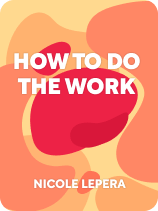

This article is an excerpt from the Shortform book guide to "How to Do the Work" by Nicole LePera. Shortform has the world's best summaries and analyses of books you should be reading.
Like this article? Sign up for a free trial here.
What are defensive behaviors? How can you categorize them? Which ones are you possibly engaging in?
You adopt defensive beliefs and behaviors to avoid feeling your pain and prevent similar painful situations from occurring, according to holistic psychologist Nicole LePera. Further, she says you adopt the same defensive beliefs and behaviors that your parents used to cope with their pain.
Read on to learn the seven defensive behavior categories, including the meaning of each, according to LePera.
Categories of Defensive Behavior
Once you’re aware of the experiences that triggered your pain in childhood, you should next categorize the defensive behaviors you developed. This will help you pinpoint the specific beliefs that prevent you from changing your patterns.
LePera claims that defensive childhood behaviors fall into one of seven categories. She suggests that you can discover the root cause of your self-sabotaging patterns by first identifying which category your behaviors fall into and then figuring out the belief behind them.
- Neglecting your own needs in favor of pleasing others: Your defensive behavior might be believing: “To feel safe and loved, I must please others.”
- Achieving success to earn approval and affection: Your defensive behavior might be believing: “To feel safe and loved, I must overachieve.”
- Avoiding attention from others to prevent criticism: Your defensive behavior might be believing: “To feel safe and loved, I must remain invisible to avoid failure or rejection.”
- Solving other people’s problems instead of facing your own: Your defensive behavior might be believing: “To feel safe and loved, I must help and protect others.”
- Appearing happy and never revealing your pain or weakness to others: Your defensive behavior might be believing: “To feel safe and loved, I mustn’t reveal my vulnerable side.”
- Acting “good” and engaging in self-sacrificing behaviors to prove your value: Your defensive behavior might be believing: “To feel safe and loved, I must appear faultless.”
- Submitting to others’ opinions instead of trusting your own instincts: Your defensive behavior might be believing: “To feel safe and loved, I must follow others.”
Other Approaches to Identify Defensive Behaviors and Beliefs
As yet, there’s no consensus on what behaviors children develop in response to painful experiences. We’ll therefore explore two approaches that other psychologists use to categorize defensive behaviors. Reviewing this information in addition to LePera’s category list might make it easier to pinpoint your own.
According to Jungian psychologists, all defensive behaviors fall into one of five archetypes of childhood trauma:
- The necessary hero: This refers to children who assumed an adult’s role and took over responsibilities beyond their age. A belief here might be: “To feel safe and loved, I must strive to be the savior for everyone except myself.
- The jester: This refers to children who acted immaturely or used humor to camouflage their emotional wounds. A belief here might be: “To feel safe and loved, I must mask my true feelings.”
- The substitute: This refers to children who adopted a protective role in an attempt to create the security that their parents failed to provide. A belief here might be: To feel safe and loved, I must take responsibility for other people’s failures.”
- The wild child: This refers to children that resorted to impulsive or provocative behaviors to get the attention they craved. A belief here might be: “To feel safe and loved, I must make others see me.”
- The aimless wanderer: This refers to children who withdrew into themselves and attempted to become invisible. A belief here might be: “To feel safe and loved, I must isolate myself.”
Meanwhile, transformational psychologists argue that specific childhood experiences triggered corresponding defensive behaviors. They categorize painful childhood experiences and the patterns they create into four broad themes:
- Harming: Your parents attacked, judged, shamed, or violated you. These parental actions made you fear other people’s anger and influenced you to believe that you’re inadequate and have reasons to feel ashamed of yourself.
- Manipulating: Your parents dominated, exploited, or betrayed you. These parental actions influenced you to act submissively, made it difficult for you to trust others, and compelled you to remain focused on your flaws.
- Rejecting: Your parents neglected, abandoned, or ignored you. These parental actions made you feel unwanted and unloved, and they convinced you that other people would always reject you.
- Undermining: Your parents degraded you and withheld affection. These parental actions made you believe that you were fundamentally flawed and unlovable.

———End of Preview———
Like what you just read? Read the rest of the world's best book summary and analysis of Nicole LePera's "How to Do the Work" at Shortform.
Here's what you'll find in our full How to Do the Work summary:
- How childhood conditioning impacts your mental and physical health
- How to develop positive patterns that improve your well-being
- Tools to feel happier, healthier, and more in control of your life






